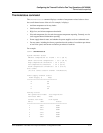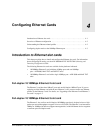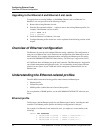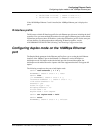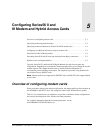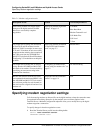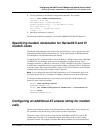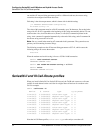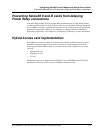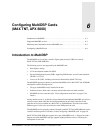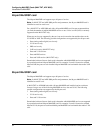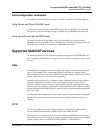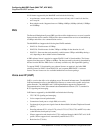
Configuring Series56 II and III Modem and Hybrid Access Cards
Specifying modem modulation for Series56 II and III modem cards
APX 8000/MAX TNT/DSLTNT Physical Interface Configuration Guide Preliminary May 9, 2000 5-3
2 List the parameters in the Modem-Configuration subprofile. For example:
admin> list modem-configuration
v42/mnp = will-v42
max-baud-rate = 33600-max-baud
modem-transmit-level = -13-db-mdm-trn-level
cell-mode-first = no
cell-level = -18-db-cell-level
7-even = no
3 Modify the parameters as required.
For information about the parameters, see the APX 8000/MAX TNT/DSLTNT Reference.
Specifying modem modulation for Series56 II and III
modem cards
The Modem-Mod parameter in the Terminal-Server profile allows you to specify the modem
modulation that Series56 II and III modems use. The possible settings are K56-Modulation,
V34-Modulation, and V90-Modulation (the default).
To support the ITU-T standard V.8bis (Voice Call Ready), a 56Kbps modem in the APX 8000
and MAX TNT unit normally sends a tone at the beginning of modem training. This is
commonly referred to as CRe and is a dual tone (1375Hz + 2002Hz) followed by a single tone
at 400Hz with a combined duration of approximately 500ms. Although V.8bis is designed not
to interfere with V.32bis modem negotiation, some V.32 and V.34 modems do not successfully
complete modem training after reception of the V.8bis tone.
Note: If you configure the Series56 II and III modems to use V.34 modulation, they never
exceed the speeds used by V.34 modems (33.6Kbps), and they do not send the V.8bis tone.
To configure modem modulation for calls coming in to Series56 II and III modem cards,
proceed as in the following example:
admin> read terminal-server
TERMINAL-SERVER read
admin> set modem-configuration modem-mod = v34-modulation
admin> write
TERMINAL-SERVER write
Configuring an additional AT answer string for modem
calls
The AT-Answer-String parameter in the Terminal-Server profile enables you to specify extra
AT commands in the answer string of the system’s modem configuration.
The answer string is the last of four strings that the APX 8000 or MAX TNT sends to the
modem upon answering a call. Commands entered in this string might overwrite settings
specified elsewhere. For example, if the Max-Baud-Rate parameter sets the maximum baud



